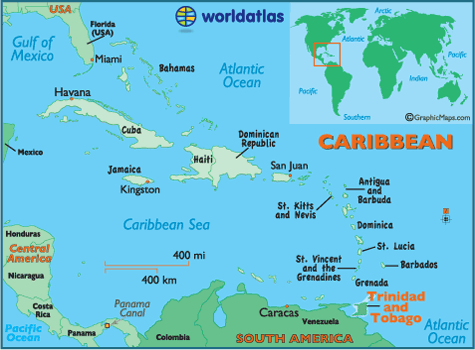Trinidad and Tobago
Area 1,980 square mi (5,128 square km)
Population 1.354 million 2014
Capital Port-of-Spain
Highest Point 3,102 ft (940 m)
Lowest Point 0 m
GDP $28.88 billion 2014
Primary Natural Resources petroleum, natural gas, cocoa, sugarcane, rice.
THE TWO CARIBBEAN SEA islands of Trinidad and Tobago had separate histories until they were joined together as one colony under the British in 1888, then as one nation upon independence in 1962. Today, the islands are among the most wealthy in the region thanks to sizeable resources of petroleum and natural gas.

Trinidad and Tobago lie off the main arc of the Antilles chain, closer and geologically more similar to VENEZUELA (only 7 mi or 11 km) than to its nearest island neighbor, GRENADA. Its mountain ranges and offshore oilfields are extensions of the same features across the narrow channels separating it from the Venezuelan mainland (called the Mouth of the Dragon and the Mouth of the Serpent). The islands also share a more continental climate—wetter and hotter—than the other islands of the Caribbean and had a fairly large native population akin to the Caribs and Arawaks on the continent. The area was therefore ripe for plantation of the two major features of the islands, religion and cash crops, reflected in the names of the two islands: Trinidad for the Holy Trinity (and also for the three peaks first spotted by Christopher Columbus in 1498), and Tobago for tobacco, grown by the natives. Neither the natives nor the tobacco survived, however, and by the 19th century, sugar plantations dominated the economy, and laborers were imported from Africa and INDIA, forming the basis of the population today. Trinidad was held by SPAIN until captured by the British in 1797. Tobago, unique among the islands of the Caribbean, started out as a colony of the Duke of Courland, a small state in the Baltic (today's LATVIA), before it too passed to British control (via Dutch and French) in 1763.
Today's population reflects this interesting ancestry, with a nearly even split between those with African and Indian ancestry. French and Spanish influences remain, intermixed with cultural elements of African and South Asian peoples—notably in the music and dance forms known as calypso. The black population lives mostly in the cities, while the Asians have spread throughout the rural areas.
Generally peaceful coexistence is sometimes disrupted by political tension, however, as demonstrated
by an unsuccessful coup in 1990 by Muslim extremists. The two islands also retain a separate identity from each other. Trinidad is physically much larger and has by far the larger population (only 51,000 people live on Tobago, compared to over 1 million on Trinidad). Trinidad also has the nation's stores of natural resources, and has therefore been more developed for industry and production, while Tobago remains largely undeveloped, focusing instead on tourism.
Trinidad is formed of three mountain ranges, roughly parallel, traveling from west to east across the island. The Northern Range is the highest. Its forested slopes plunge vertically into the sea along the northern coast. Most of the population lives in an urban corridor extending east and west from the capital, Port-of-Spain, along the southern flanks of the Northern Range.The center of the island is flat and is home to most of the sugar industry but also other tropical crops like rice and cacao. Oil and gas reserves are found in the southwestern part of the island and also offshore. Besides developing itself as a producer of crude oil, Trinidad is a center for refining and reexporting oil products from Venezuela. These businesses have been booming for the last decade and have helped contribute to the stable economy (about a fourth of the gross domestic product) that has established Trinidad's reputation as a great site for foreign investment.
Tobago, 20 mi (32 km) to the northeast, is volcanic in origin, with a central range of hills, and a flat coralline coastal area in the southwest, where the island's principal town, Scarborough, is located. Tobago is cooler and drier than Trinidad, with isolated inlets and beaches, that are becoming the island's chief draw for tourism. Trinidad and Tobago lies south of the Caribbean hurricane belt, meaning greater security for island investors. It is hoped that these newer industries, foreign investment and tourism, will keep the country's prosperity going when the oil runs out in the not too distant future.